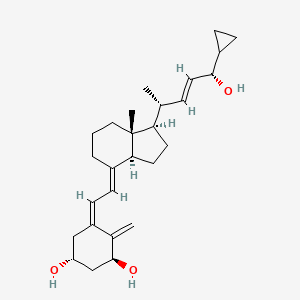D0831 | calcipotriene
| Toxicity | Dose | Time | Species | Model | Method | Action | Positive criterion | Reference |
|---|---|---|---|---|---|---|---|---|
| MEMBRANE POTENTIAL | 25.98±3.89 | human | qHTS-HepG2 | MMP assay | decrease | IC50 | 163 | |
| MEMBRANE POTENTIAL | 21.82 | human | HepG2 | MMP assay | decrease | IC50 | 163 | |
| MEMBRANE POTENTIAL | 17.34±0.00 | rat | hepatocytes | MMP assay | decrease | IC50 | 163 | |
| Pictogram | Signal | Statements | Precautionary Statement Codes |
|---|---|---|---|
   |
Danger |
Aggregated GHS information provided by 4 companies from 3 notifications to the ECHA C&L Inventory. Each notification may be associated with multiple companies. H300 (75%): Fatal if swallowed [Danger Acute toxicity, oral] H310 (50%): Fatal in contact with skin [Danger Acute toxicity, dermal] H311 (50%): Toxic in contact with skin [Danger Acute toxicity, dermal] H315 (25%): Causes skin irritation [Warning Skin corrosion/irritation] H319 (25%): Causes serious eye irritation [Warning Serious eye damage/eye irritation] H330 (50%): Fatal if inhaled [Danger Acute toxicity, inhalation] H335 (25%): May cause respiratory irritation [Warning Specific target organ toxicity, single exposure Respiratory tract irritation] H362 (25%): May cause harm to breast-fed children [Reproductive toxicity, effects on or via lactation] H372 (50%): Causes damage to organs through prolonged or repeated exposure [Danger Specific target organ toxicity, repeated exposure] Information may vary between notifications depending on impurities, additives, and other factors. The percentage value in parenthesis indicates the notified classification ratio from companies that provide hazard codes. Only hazard codes with percentage values above 10% are shown. |
P201, P260, P261, P262, P263, P264, P270, P271, P280, P284, P301+P310, P302+P350, P302+P352, P304+P340, P305+P351+P338, P308+P313, P310, P312, P314, P320, P321, P322, P330, P332+P313, P337+P313, P361, P362, P363, P403+P233, P405, and P501; (The corresponding statement to each P-code can be found at the GHS Classification page.) |
 |
Danger |
The GHS information provided by 1 company from 1 notification to the ECHA C&L Inventory. H301 (100%): Toxic if swallowed [Danger Acute toxicity, oral] H311 (100%): Toxic in contact with skin [Danger Acute toxicity, dermal] H331 (100%): Toxic if inhaled [Danger Acute toxicity, inhalation] |
P261, P264, P270, P271, P280, P301+P310, P302+P352, P304+P340, P311, P312, P321, P322, P330, P361, P363, P403+P233, P405, and P501; (The corresponding statement to each P-code can be found at the GHS Classification page.) |
| Organism | Test type | Route | Dose (normalized dose) | Effect | Source |
|---|---|---|---|---|---|
| rat | LD50 | skin | > 15mg/kg (15mg/kg) | Journal of Toxicological Sciences. Vol. 21(Suppl, | |
| women | TDLo | skin | 10gm/kg/6W-I (10000mg/kg) | British Medical Journal. Vol. 306, Pg. 896, 1993. | |
| dog | LD50 | skin | > 1500ug/kg (1.5mg/kg) | Journal of Toxicological Sciences. Vol. 21(Suppl, | |
| man | TDLo | skin | 11gm/kg/11W-I (11000mg/kg) | British Medical Journal. Vol. 306, Pg. 896, 1993. | |
| rat | LD50 | subcutaneous | 2190ug/kg (2.19mg/kg) | Journal of Toxicological Sciences. Vol. 21(Suppl, | |
| (1?,3?,5Z,7E,22E,24S)-24-Cyclopropyl-9,10-secochola-5,7,10(19),22-tetraene-1,3,24-triol | (1R,3S,5Z)-5-[(2E)-2-[(1R,3aS,7aR)-1-[(E,2R,5S)-5-cyclopropyl-5-hydroxypent-3-en-2-yl]-7a-methyl-2,3,3a,5,6,7-hexahydro-1H-inden-4-ylidene]ethylidene]-4-methylidenecyclohexane-1,3-diol | (1S,3R,5Z,7E,14beta,17alpha,22E,24S)-26,27-cyclo-9,10-secocholesta-5,7,10,22-tetraene-1,3,24-triol |
| (1S,5Z,7Z,17ALPHA,22E)-24-CYCLOPROPYL-9,10-SECOCHOLA-5,7,10,22-TETRAENE-1,3,24-TRIOL | (22E)-(24S)-1alpha,24-dihydroxy-26,27-cyclo-22,23-didehydrovitamin D3 / (22E)-(24S)-1alpha,24-dihydroxy-26,27-cyclo-22,23-didehydrocholecalciferol / Calcipotriol | (5Z,7E,22E)-(1S,3R,24S)-26,27-cyclo-9,10-seco-5,7,10(19),22-cholestatetraene-1,3,24-triol |
| (5Z,7E,22E,24S)-24-Cyclopropyl-9,10-secochola-5,7,10(19),22-tetraene-1alpha,3beta,24-triol | (5Z,7E,22E,24S)-24-Cyclopropyl-9,10-secochola-5,7,10(19),22-tetraene-1alpha,3beta,24-triol hydrate | (5Z,7E,24S)-26,27-Cyclo-9,10-secocholesta-5,7,10(19),22-tetraene-1alpha,3beta,24-triol; |
| 1-ALPHA,24S-(OH)2-22-ENE-26,27-DEHYDROVITAMIN D3 | 112828-00-9 | 112965-21-6 |
| 143NQ3779B | 1s19 | 24207-EP2275420A1 |
| 24207-EP2295055A2 | 24207-EP2295416A2 | 24207-EP2298748A2 |
| 24207-EP2298764A1 | 24207-EP2298765A1 | 24207-EP2305640A2 |
| 24207-EP2305642A2 | 24207-EP2308861A1 | 24207-EP2311453A1 |
| 24207-EP2314590A1 | 828C009 | 9,10-Secochola-5,7,10(19),22-tetraene-1,3,24-triol, 24-cyclopropyl-, (1alpha,3beta,5Z,7E,22E,24S)- |
| AB00698343-05 | AKOS015855239 | AS-56390 |
| BDBM50369964 | BMS-181161 | CAS-112965-21-6 |
| CCG-100949 | CCRIS 7700 | CHEBI:50749 |
| CHEMBL1200666 | CPD000466353 | CS-0387 |
| Calcipotriene (USAN) | Calcipotriene [USAN] | Calcipotriol |
| Calcipotriol (JAN) | Calcipotriol [INN] | Calcipotriol hydrate |
| Calciptriol | Calcitrene | D01125 |
| DB02300 | DSSTox_CID_26648 | DSSTox_GSID_46648 |
| DSSTox_RID_81793 | DTXSID0046648 | Daivonex |
| Divonex | Dovonex | Dovonex (TN) |
| Epitope ID:114242 | GTPL2778 | HMS2051N11 |
| HMS2089J08 | HMS3269P03 | HMS3413D04 |
| HMS3677D04 | HMS3713K08 | HY-10001 |
| LMST03020106 | LWQQLNNNIPYSNX-UROSTWAQSA-N | MC 903 |
| MC-903 | MC903 | MFCD10567086 |
| MLS000759467 | MLS001424130 | NC00199 |
| NCGC00167465-01 | NCGC00167465-02 | O763 |
| PRI 2201 | PRI-2201 | Psorcutan |
| PubChem18810 | PubChem19334 | Q155683 |
| SCHEMBL2853 | SMR000466353 | SR-01000762910 |
| SR-01000762910-3 | SR-01000762910-4 | STF-115469 |
| Sorilux | Tox21_112469 | Tox21_112469_1 |
| U-0267 | UNII-143NQ3779B | W-5148 |
| ZINC3921872 | calcipotriene | s3739 |

